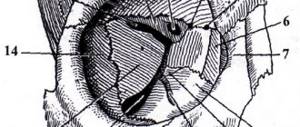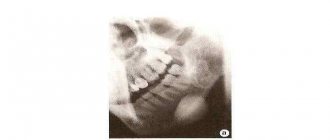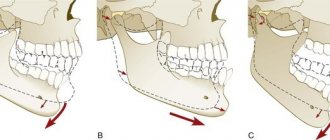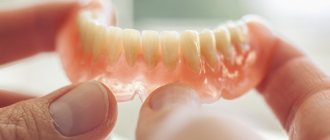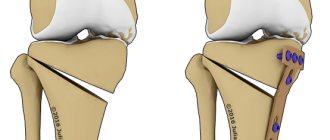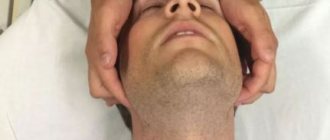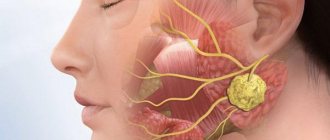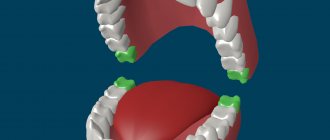2062
Osteosynthesis as a technique for restoring the integrity of the jaw bone has been carried out since the 19th century. The first operation was carried out in 1825, during which fragments of the lower jaw were connected with silver wire.
A little later, this technique was called “bone suture”, and is still the main one of all existing ones in osteosynthesis.
General overview
Osteosynthesis is a surgical method for treating various fractures of the jaw bone, which consists of connecting its broken elements using various devices and materials.
The procedure has a significant advantage over other methods of jaw restoration, since it minimizes the likelihood of damage to tissues adjacent to the injured area, and also completely (or almost completely) restores the functionality of the bone . The method of execution is divided into 4 varieties.
With the open method, immobilization of jaw fragments occurs with tissue incision and exposure of the ends of the fragments. This technology makes it possible to accurately correlate all elements, remove small fragments, and remove severely damaged tissue.
The closed version involves securing the broken elements without cutting the tissue at the broken site. Their fixation occurs with extraoral apparatuses.
During the focal type of osteosynthesis , devices that fix the fragments are passed through the fracture or adjacent to it. With the extrafocal method, the fastening devices go through the fracture over non-injured tissues or are located outside it.
In practice, a combination of jaw restoration techniques is used, rather than each one separately.
Indications
Osteosynthesis is justified in situations where other methods of therapy do not give the desired effect. The procedure is indicated in the following cases:
- Insufficient number of resistant units in the area of damage to the jaw bone.
- Severe displacement of most of the bone elements , the reduction of which cannot be performed without surgical intervention.
- Pathological damage to the jaw resulting from an infectious (inflammatory) bone lesion.
- Multiple splintered fractures of the jaw processes.
- Serious bone defects.
- Performing reconstructive or plastic manipulations in the maxillofacial area.
Technique for plasty of the anastomosis with the maxillary sinus and possible complications.
In this article we will tell you how clinical teeth lengthening is performed.
Follow the link https://zubovv.ru/hirurgiya/rezektsiya/periostotomiya-operatsiya.html if you are interested in the meaning of periostotomy in dentistry.
Public method
Options for performing an open type of osteosynthesis can be the use of:
- bone suture;
- quick-hardening plastic mass;
- metal staples;
- miniature bone plates;
- adhesive mass "Osteoplast".
Significant disadvantages of open osteosynthesis are:
- tissue must be peeled away from the bone;
- tissue hypoxia may develop;
- After surgery, scarring of the skin occurs;
- paralysis of facial muscles is possible.
Bone suture
The application is indicated for a “fresh” fracture of the jaw (zygomatic) bone, or for damage with easily reducible fragments.
Important! If these indications reveal an abscess, an inflammatory infiltrate, or the fracture was caused by a gunshot injury, osteomyelitis, and there are oblique or displaced fractures, many small fragments, manipulation with suturing is not performed.
To carry out the operation, a wire made of titanium, tantalum, steel or a nylon thread with a diameter of 0.6 mm to 0.9 mm is used.
During osteosynthesis, the surgeon makes an incision in the skin, exposes the ends of the fragments from the vestibular and lingual surfaces, collects them and connects them together with a wire passed through holes made in the bone.
The advantage of the technique is that the chewing function is fully preserved. It is also possible to carry out daily oral hygiene without developing pathologies in the condylar process.
Using mini bone plates
Indications for this technique are all kinds of jaw fractures, except for multiple small-fragmented fractures. A significant advantage of this operation is that the formation of access to the bone occurs only from the side of the surface facing the vestibule of the mouth (vestibular), which practically does not affect microcirculation in this area.
To connect jaw fragments, titanium or steel mini-plates of different shapes are taken. The length of these devices ranges from 2.5 cm to 22 cm, with a thickness of 1-1.5 mm. To secure the plates, screws with a length of 5–19 mm and a diameter of 2.0 and 2.3 mm are used,
During this type of operation, the skin is dissected, the ends of the fragments are exposed by 2.0 mm on the vestibular side, then they are compared with each other and fastened with plates that are screwed onto screws.
Modern technologies make it possible to carry out immobilization using the intraoral (intraoral) method, i.e. without cutting the skin.
Fast-hardening plastics
Performing an operation using this technique is permitted only when the body of the lower jaw is broken. Limitations to its implementation are comminuted small fractures or damage to the condylar process.
Osteosynthesis occurs in the following sequence:
- Exposure of bone fragments.
- Their comparison.
- Drilling a special groove on their front surface.
- Packing the plastic mass into this chute.
- Removing excess material with a milling cutter.
- Stitching the wound.
Metal staples
The device is made of titanium-nickel wire 1.6 mm in diameter. The peculiarity of this material is that it softens, easily changes shape when strongly cooled, and quickly recovers at room temperature.
Depending on the severity and location of the problem, different shaped brackets can be used. They are superimposed on the exposed ends of the fragments. Then, retreating 1.2-1.5 cm from the site of damage, through tubules are drilled into them.
Important! The spacing between these holes should be greater than the spacing between the “legs” of the staples.
Each staple is cooled with chloroethyl, stretched, and then their ends are inserted into the prepared tubules. After installing the brackets, they warm up and quickly return to their original sizes, immobilizing the jaw fragments.
Glue "Osteoplast"
This is a type of epoxy resin with a special filler that hardens in 5-7 minutes. at room temperature.
After applying glue to the exposed edges of the fragments, they should be kept motionless for about 15 minutes. until the glue has completely hardened.
In what cases is it impossible to do without surgery to remove the hood of a wisdom tooth, and how long does the recovery period last?
Find out about the effectiveness of gum flap surgery here.
At this address we will discuss all the nuances of performing an alveolotomy.
Titanium Plates for Fractures: Price, Types, Rehabilitation
The fourth group contains such an element as Titan.
It is a lightweight, durable metal with a silvery-white color. This element received its name from the characters of ancient mythology, the children of Gaia. In nature, this element ranks tenth in abundance. Depending on purity, titanium costs approximately six dollars per kilogram. Often with fractures or injuries, life becomes much harder, not so active and mobile. Medicine today uses titanium plates for fractures.
Titanium plates after fracture
Titanium plates have a beneficial effect on bone integrity. They contribute to their recovery. Also, these components help the bones perform their functions in a short period of time. If we talk about mechanical functions, then this is support, movement and protection of internal organs. Orthopedists and surgical specialists use different methods for their application.
Moreover, each section has suitable options. When installing and fastening, special devices and tools are used. They simplify this process and make the final result more effective. Depending on where the bone is broken, the type of plate and its further function depend. If the pressure is above 130/90, the blood vessels need to be cleaned.
The easiest way: drink a decoction of Read more... for 7 days
Variety
The plate itself comes in several types. This is the one that performs a protective function (neutralization), support (support), compression, and when constricting broken bones. Four species in the classification section.
Metal osteosynthesis is a prescription for placing titanium plates on the bone.
There are indications for any disease. This case is no exception. Indications
- when a fragment is displaced in the bones as a result of a traumatic process,
- X-ray found a couple of pieces of debris,
- the patient does not have serious diseases that contradict surgical intervention by specialists,
- it is necessary to restore lost physiological functions to the damaged area of the limb,
- There are no complications for using anesthesia.
When older people suffer from bone fractures, especially if they have signs of osteoporosis that is about to begin, the plates are left in their place after surgery. Despite the fact that this is a foreign body, in this case it will be more appropriate.
When you receive a blow to the face, often after a sports competition, your jaw and teeth suffer. Titanium plates for jaw fractures are placed within a couple of days immediately after the injury.
For proper fusion, the jaw is fixed in the correct position. After the operation, the patient spends several more days in a specialized institution, about a month.
The procedure is relatively simple.
Titanium plate for arm fracture
“This remedy treats joints even in the most hopeless cases of fractures, dislocations and sprains” Read more..., In this case, different shapes and sizes are used. Plates are not placed on damaged palmar parts.
After all, in this part there are many nerve endings, there are ligaments, muscles, they can easily be damaged by the plate.
The dorsal surface is often used, where the bones are close to the skin, plus there are fewer nerve endings.
Specialists connect damaged areas with the support of plates, and dense formations of connective tissue - thanks to fasteners, which holds any structure.
The titanium plate for the arm fracture remains on the damaged area for about a year, after which it is removed during the next operation. Before removal, the specialist checks whether the bones need additional fixation or not.
Lower limbs
Leg fracture titanium plate is used inert. It is installed during surgery by a surgeon.
- broken bones that did not heal properly,
- broken bones that have not healed for a long time.
They connect a solid organ of a living organism after cleaning the affected areas from debris. Specialists use an external fixation device for complicated cases.
If the hip is damaged, a pin is used, it is fixed using screws. Depending on the location of the fracture, pins are inserted there. When administering, a navigator is used to calculate the injection most accurately.
If the patient has a tibia fracture, then the use of direct fixing elements is relevant. The type is determined by the location of the damage. If the shin bones do not heal properly, an AVF is used.
If the metatarsal bone materials are damaged due to a fracture, then small plates are used. They are used in orthopedic surgery due to the curvature of the big toes.
Rehabilitation period
After the installation of these plates, the patient’s recovery plays a huge role. It must be timely and complete.
On average, it takes no more than one month, but there are complicated options in which the patient stays in the hospital ward for a longer period of time. Not the least role in this process is played by desire and human effort.
A good operation and rehabilitation after it are interconnected. Violation of this equation destroys all the work done by doctors.
There are even special complexes of physical activity and a methodical plan that will help a person properly restore strength.
Removal
First of all, such a plate is a foreign body in the patient’s body; over the next period of time it can separate. A cyst forms around the place where the plates were. The traumatologist individually solves these problems with the person.
Price
Titanium plates for fractures, the price is proportional to the quality and depends on the place where the product was manufactured. Imported products are more expensive and, in most cases, better quality.
They are bought in dollar currency, and accordingly, in terms of price level they are much higher than domestic ones. Titanium plates for fractures can be purchased in large cities and centers, despite the fact that almost all cities provide surgical treatment.
The cost of titanium plates for fractures ranges from twenty to fifty thousand rubles.
Loading…
Source: https://beauty-love.ru/zdorove/zdorovoe-pitanie/titanovyie-plastinyi-pri-perelomah
Closed focal method
This technique for reconstructing the jawbone is indicated when it is damaged without displacement. The technology does not involve tissue peeling, which preserves microcirculation in full. The technique does not lead to complications or negative consequences.
Kirchner spokes
The devices are recommended for use in case of damage to the jaw on the side, in case of difficult-to-reduce fragments and the impossibility of their reduction by hand, in case of tissue interposition or a fracture in the chin area with the simultaneous use of a wire ligature.
Before applying the wires, the ends of all fragments are exposed and reduced. Using a surgical drill (drill), the doctor inserts a metal pin one by one into all bone fragments, leaving its ends approximately 5 mm apart.
Important! The technique is minimally invasive and does not cause the patient much inconvenience or discomfort.
Surround seam
The main indications for this option of osteosynthesis are the following conditions:
- lack of many teeth;
- osteomyelitis;
- a small number of stable units on the wreckage;
- bone suppuration;
- its pathological breaking.
To apply a suture, a ligature made of nylon or wire with a diameter of up to 0.8 mm is used. It is inserted with a thin curved needle . If the fracture is one-sided, one suture is placed on the jaw on both sides of the gap at a distance of 1.7-2.0 mm from it.
This technique can act as an independent method of jaw restoration or be supplemented with the use of supragingival splints and a prosthesis.
The video presents the stages of osteosynthesis of the angle of the lower jaw.
Titanium plates for jaw fractures photo
The lower jaw is the only movable bone of the head. It is unpaired and is located at an angle to the base of the skull and upper jaw. This determines the increased susceptibility of this bone to fractures.
And the muscles that are attached to it, providing mobility, also provide serious displacement of the fragments during a fracture. The lower jaw accounts for almost 70% of cranial skeletal injuries.
Therapy methods
The method of neutralizing the consequences of injury will depend on related factors:
- Type of fracture. Open fractures associated with bone crushing and/or affecting other organs require hospitalization and splinting.
- Possibility of immediate transportation of the patient to a medical facility.
- General condition of the victim.
- Possibility of treatment in a clinic setting. In some cases, it is necessary to be sent to a hospital (hospital), because there are no drugs or instruments on site, or the doctor is not sufficiently qualified.
The choice of method should be based on the patient’s needs, taking into account minimal consequences for his health and shortening the rehabilitation period.
We invite you to watch a short video that briefly describes the types of fractures and treatment features:
First aid
The most important thing in case of a fracture of the lower jaw is to fix it in a stationary position until the doctor arrives.
For this, a bandage is used that passes under the chin and is tied at the crown of the head; if possible, it makes sense to secure it additionally horizontally, on the forehead. As a last resort, a motorcyclist's helmet, hard hat, or even a hat with ear flaps will do.
If a person has difficulty breathing, it is important to remove foreign objects from their mouth before restraining them.
. The tongue must be removed from the mouth. As a last resort, it can be pierced with a sterilized pin to prevent it from entering the respiratory tract.
If the victim is in shock, he must constantly maintain a sitting or standing position.
Orthopedic (conservative) therapy
This type of treatment comes down to applying splints or prostheses.
. Splinting can be dental, supragingival or mixed. Depending on the material, prostheses are divided into metal and plastic.
Tires began to be produced at the beginning of the last century. Since then, their design has undergone many changes. But all tires, from the very first ones created by Tigerstedt to modern custom models, have negative consequences.
Popular types of tires are:
- standard Vasiliev tape tire with hooking loops, secured with bronze-aluminum wire. It is made of stainless steel, has parameters of 0.26-0.28 mm. Included in first aid kits. The surgeon gives the desired shape to the splint manually;
- plastic tire Urazalina . It looks like an arc with a cross-section in the shape of an ellipse, the hooks are located along the lower edge of the base, around it on three sides there are through channels for threading the fixing thread. It is put on the teeth from the outside and secured to at least three teeth, fixed with rubber rings on the hooks;
- universal bent wire tire of Tigerstedt. Made of aluminum, bent by hand. There are 5 types: single-jaw smooth connecting splint-bracket, single-jaw connecting splint with a spacer bend, with hooking loops for intermaxillary fixation, single-jaw with an inclined plane, single-jaw with a supporting plane;
- single-jaw compression-distraction splint.
The main disadvantages of this method of treatment are:
- Injuries to the mucous membrane of the lips.
- Difficulties in oral hygiene.
- Leukoplakia (erosion) of the mucous membrane as a result of galvanic currents (applies to all metal tires).
- Possibility of allergies.
- Dental injuries (dislocations, fractures), malocclusion, which even after rehabilitation can be permanent.
For this reason, modern dentists and surgeons tend to consider splinting only as a temporary measure to fix the bone.
, giving preference in most cases to osteosynthesis of the jaw.
Surgery (osteosynthesis)
Indications for surgical intervention are:
- Missing teeth or loose teeth.
- Soft tissue damage.
- Multiple fractures.
To fuse the bone and fix the fragments, splints, pins, knitting needles and wires of a special design are used. It is also possible to apply a special glue to the bone, which allows for a more complete alignment of the surfaces and speeds up healing.
The main disadvantage of osteosynthesis is the high risk of complications.
(according to Russian scientists presented in 1997 - 27%). Most often, this is an infection of the oral cavity or corrosion of the metals used to connect bones.
Modern technologies and high professionalism of specialists make it possible to reduce the likelihood of such an outcome; one can hope that over time it will be minimized.
The essence of the orthopedic process in a hospital setting
When you get to the hospital with a fracture of the lower jaw, the first thing you need to insist on is pain relief
. Not all surgeons believe that it is necessary. The patient’s task in this case is to provide information about drugs to which they may be allergic and to adequately assess their pain threshold.
Source: https://m-star68.ru/titanovye-plastiny-pri-perelomah-cheljusti-foto/
Rehabilitation period
The effectiveness of the operation and the patient's recovery time depend on several factors:
- time of manipulation relative to the period of injury;
- complexity and extent of the fracture;
- chosen osteosynthesis option.
An important influence on recovery is exerted by the general condition of a person, as well as the presence of acute and chronic pathologies.
Important! Taking antibiotics and restorative drugs significantly reduces the possibility of complications and negative consequences, thereby reducing the recovery period.
Carrying out physical procedures, therapeutic exercises, as well as proper and regular oral hygiene contribute to the complete restoration of the functionality of the jaw.
Thus, physiotherapy promotes the healing of bone tissue and normalizes the condition of the body. The procedure combines several techniques based on the influence of one of the physical factors (heat, cold, electromagnetic waves, vibration, etc.). May be assigned:
- ultra-high frequency electromagnetic field;
- low frequency magnetic pulse therapy;
- irradiation of the fracture area with ultraviolet light;
- calcium electrophoresis.
Under the influence of these techniques, mechanisms are activated that have a positive effect on bone tissue and the body itself.
When the splints are removed (this is around the 4th week), you can perform therapeutic exercises . It will help restore swallowing and chewing functions, facial expressions and speech.
Particular attention should be paid to nutrition . During this period, the food regime in chemical and mechanical terms must be gentle and must cover the body’s daily need for nutrients. All food taken should be crushed, diluted to a semi-liquid state and heated to 45-50⁰C.
For the first few days , you need to wear a fixing bandage , limit the mobility of the jaw, i.e. try not to chew or talk.
Specifics of treatment of mandibular fractures
3589
The lower jaw is the only movable bone of the head. It is unpaired and is located at an angle to the base of the skull and upper jaw. This determines the increased susceptibility of this bone to fractures.
And the muscles that are attached to it, providing mobility, also provide serious displacement of the fragments during a fracture. The lower jaw accounts for almost 70% of cranial skeletal injuries.
Dental splints
dental splint: a - in the manufacturing process; b - completely ready
Used when there are at least three healthy teeth in the jaw
. The splint in this case is a wire with which the jaw bone is wound to the base of the teeth. If there are not enough of them at the fracture site or there is displacement of the fragments, an additional spacer is installed.
Splints may affect one or both sides of the jaw. In the second case, a more massive structure and rigid wire are used.
In case of a fracture in the area of the dentition or a fracture of both the upper and lower jaw, it is necessary to use a double-jaw splint. Loops or hooks are attached to the even teeth, onto which the tires are fixed.
The hinges of the upper and lower jaws are connected by rubber rings. This design limits mobility; feeding is only possible through a tube.
The following video shows this procedure in detail:
Dental and supragingival splints
Such designs are used in the absence of healthy teeth on which the splint can be attached. Most often, a monolithic plastic plate is used, in which a hole is made for receiving liquid food. For minor fractures, the patient may be able to use removable dentures.
If the patient's teeth are loose, the splint is attached to holes in the bone, which are drilled in the alveolar part
. This allows you to avoid removal and achieve immobilization (immobility) of parts of the jaw.
Stages of osteosynthesis
The operation is performed under mandatory local anesthesia. Before the procedure, you must abstain from eating for 6 hours. The operation consists of the following steps:
- After the anesthetic has taken effect, an intraoral or extraoral incision is made.
- The wound is cleaned of debris, blood clots, and damaged soft tissue.
- The bone is exposed and the periosteum peels off.
- The bone fragments are connected using wire, knitting needles or plates.
- Soft tissues are connected and sutures are applied.
Sometimes, if there is a lack of bone tissue or a late diagnosis of a fracture, it may be necessary to use tissue from other bones in the body.
Thus, in the Dental Journal (2004), a case was described when a twenty-year-old patient, after applying a splint after the prescribed period, did not have positive dynamics and suppuration began. The problem was successfully resolved after surgery using tissue from the ilium (pelvic area) and a course of antibiotics.
Recently, so-called sustainable osteosynthesis has come into practice. It allows you to fix the bones with minimal surgical intervention. This osteosynthesis takes place without incision of the periosteum.
The method is suitable for a limited number of fractures, but has already shown its effectiveness and a high degree of adaptation of the devices used.
The cost of standard osteosynthesis in private clinics starts from 25,000 rubles
. In case of complex operations or unusual jaw structure, individual production of a connecting structure may be necessary. In this case, the price will be correspondingly higher.
Features of therapy of the articular head (process)
bilateral fracture of the lower jaw in the area of the articular processes
Such fractures are usually an indication for surgery, especially if they are accompanied by dislocation of the head. The connection of bone fragments can occur by removing them from the wound and subsequent fixation as part of a complex implant
.
Another method is fusion using a sharp needle
. This method has quite a few contraindications and is used only for massive jaws. Otherwise, the head may split.
An alternative is a hardware method of treatment.
It comes down to external fixation of bone fragments. A system of hook-clamps, rods and screws is used. It is attached to the patient's head.
An incision is made in the area of the fracture, and the bone is fixed with hooks. Soft tissues are sutured in layers. The wearing time of the device can be up to 1.5-2 months.
Therapy at home
You should only resort to first aid yourself. If it is impossible to deliver the victim to the hospital, it is worth taking care of fixing the lower jaw, stopping the bleeding in an open wound, and disinfecting.
If signs of infection are observed (fever, fever, swelling), broad-spectrum antibiotics may be taken. In addition to applying a fixing bandage, it is worth limiting the mobility of the lower jaw as much as possible: do not talk, do not chew (eat liquid food) until visiting a doctor.
A fracture of the lower jaw can be easily cured with competent and timely consultation with a specialist.
. A modern arsenal of tools allows you to maintain an attractive appearance after rehabilitation, as well as achieve complete restoration of lost functions.
Rehabilitation
The rehabilitation period depends on the general condition of the patient’s body. On average, the splint is applied for a period of one and a half to two months.
Throughout the treatment there will be pain, this is normal. The process of removing the splint is also painful.
In order not to harm the fusion of bones, you need to follow the doctor's instructions. Patients have particular problems with eating and maintaining oral hygiene, because... the jaw is fixed.
How to eat properly
Chewing is prohibited, even when eating mushy soft food. Patients with a jaw splint eat as follows:
- Only dishes with the consistency of liquid sour cream are allowed so that they can be swallowed immediately. A tube is inserted into the mouth and the patient eats food using suction movements.
- If possible, food should not get on your teeth, because... cleaning them is impossible, and rotting of the remaining liquid nutrition will lead to the development of pathogenic microflora, which is dangerous, especially with an open fracture.
- The food should not contain seeds or other impurities.
For example, these are formed when preparing a milkshake from kiwi or strawberries. There is a possibility of choking, which will lead, firstly, to the inability to cough well and remove a foreign body, and secondly, to the physical impact of coughing on the healing bones and disruption of the process, increased rehabilitation time and complications. - It is recommended to consume fermented milk products daily, rich in calcium, which is necessary to improve the process of bone fusion.
Reviews
Osteosynthesis is a simple dental operation, the technique of which has been worked out quite well. It helps restore the integrity and functionality of the jaws to their full extent.
You can share your feedback and impressions about this manipulation and the features of the recovery period in the comments to this article.
If you find an error, please select a piece of text and press Ctrl+Enter.
Tags jaw osteosynthesis surgery
Did you like the article? stay tuned


